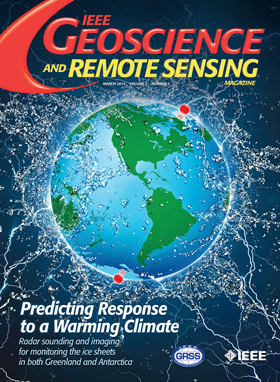Polarimetric Roll-Invariant Features and Applications for Polarimetric Synthetic Aperture Radar Ship Detection: A comprehensive summary and investigation
IF 16.2
1区 地球科学
Q1 GEOCHEMISTRY & GEOPHYSICS
引用次数: 0
Abstract
Polarimetric radar, which can acquire full polarization information, has become mainstream in microwave remote sensing. However, radar target scattering responses are strongly orientation dependent, which makes applications such as target detection and recognition more difficult. Polarimetric roll-invariant features, which are independent of target orientations along the radar line of sight (LOS), exhibit great importance and have achieved successful applications in many fields. During the development of radar polarimetry, a number of polarimetric roll-invariant features have been found and reported. A comprehensive summary and investigation of these polarimetric roll-invariant features is necessary and valuable for current studies and further developments. This article is dedicated to this purpose and contains two main contributions. First, according to the authors’ knowledge, polarimetric roll-invariant features are thoroughly investigated. Based on their original derivation fashion, they are partitioned into six groups, including those derived from the Sinclair matrix, the Graves matrix, the polarimetric coherency and covariance matrices, eigenvalue–eigenvector-based decompositions, polarimetric coherence/correlation patterns, and the Kennaugh matrix. Meanwhile, their expressions, inner relationships, and physical interpretations are further examined and presented. Second, since ship detection is an important application for polarimetric synthetic aperture radar (PolSAR), the potential of these independent features for PolSAR ship detection is investigated and demonstrated. Experimental studies with偏振合成孔径雷达船舶探测的偏振滚动不变特性和应用:全面总结和调查
偏振雷达可获取全偏振信息,已成为微波遥感的主流。然而,雷达目标散射响应强烈依赖于方位,这使得目标探测和识别等应用变得更加困难。偏振滚动不变特征与雷达视线(LOS)上的目标方位无关,具有重要意义,并在许多领域取得了成功应用。在雷达偏振测量学的发展过程中,人们发现并报道了许多偏振滚动不变特征。对这些偏振滚动不变特性进行全面总结和研究,对于当前的研究和进一步发展是非常必要和有价值的。本文就是为此目的而写的,主要有两方面的贡献。首先,根据作者的知识,对极坐标滚动不变特征进行了深入研究。根据其原始推导方式,将其分为六组,包括从辛克莱矩阵、格雷夫矩阵、极坐标相干性和协方差矩阵、基于特征值-特征向量的分解、极坐标相干/相关模式和 Kennaugh 矩阵推导出的特征。同时,还进一步研究和介绍了它们的表达式、内在关系和物理解释。其次,由于船舶探测是偏振合成孔径雷达(PolSAR)的一项重要应用,因此研究并展示了这些独立特征在 PolSAR 船舶探测中的潜力。利用雷达卫星-2(RADARSAT-2)和高分-3 PolSAR 数据集进行了实验研究。结果证明,与普通偏振特征相比,所选的偏振滚动不变特征表现出更优越的性能。
本文章由计算机程序翻译,如有差异,请以英文原文为准。
求助全文
约1分钟内获得全文
求助全文
来源期刊

IEEE Geoscience and Remote Sensing Magazine
Computer Science-General Computer Science
CiteScore
20.50
自引率
2.70%
发文量
58
期刊介绍:
The IEEE Geoscience and Remote Sensing Magazine (GRSM) serves as an informative platform, keeping readers abreast of activities within the IEEE GRS Society, its technical committees, and chapters. In addition to updating readers on society-related news, GRSM plays a crucial role in educating and informing its audience through various channels. These include:Technical Papers,International Remote Sensing Activities,Contributions on Education Activities,Industrial and University Profiles,Conference News,Book Reviews,Calendar of Important Events.
 求助内容:
求助内容: 应助结果提醒方式:
应助结果提醒方式:


